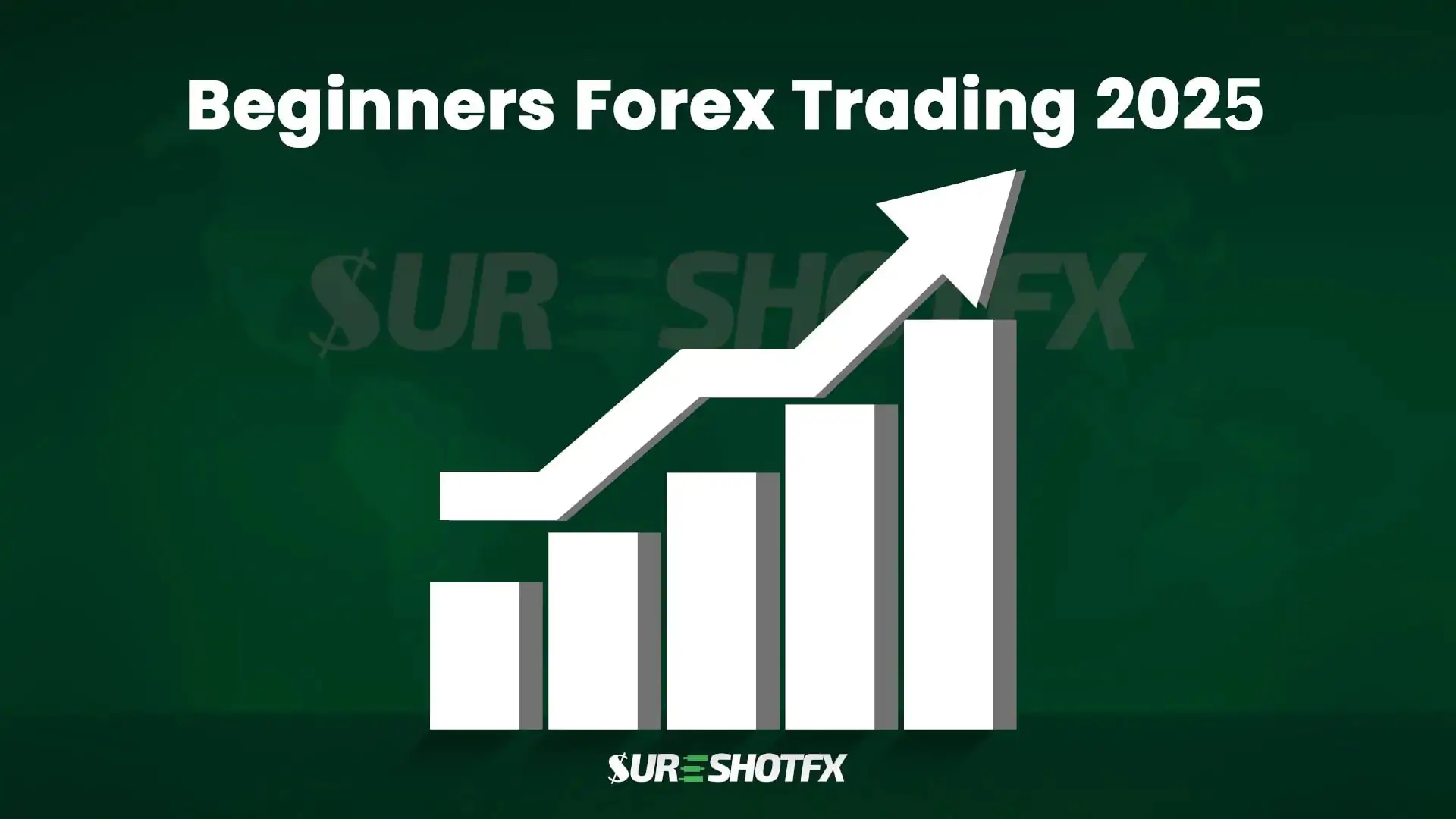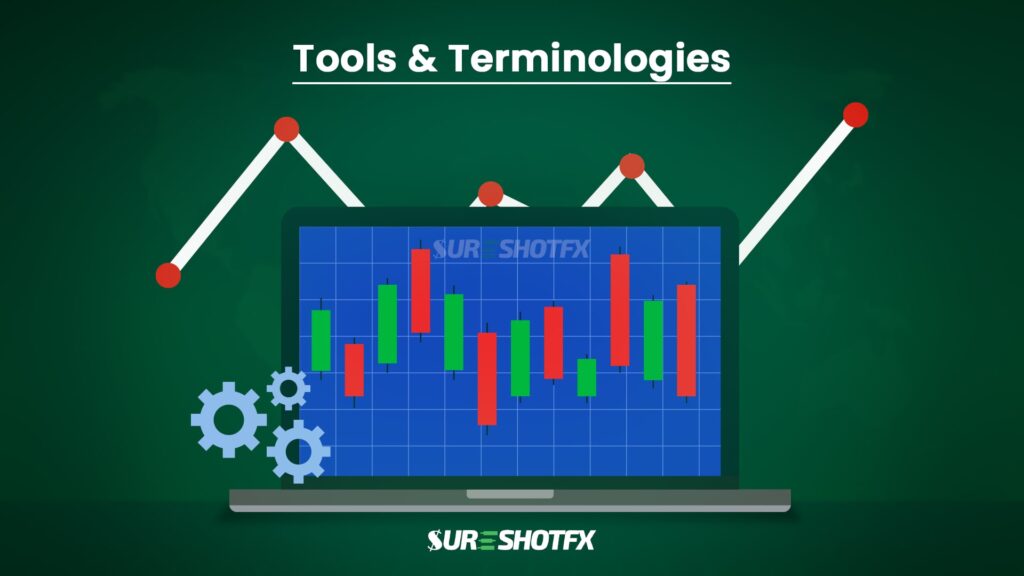Forex Trading for Beginners: Guide for 2025

Learning forex trading from scratch can be difficult as it’s a large market and there are a lot of things to learn. Our Forex trading for beginners guide is dedicated to those traders who are getting started this year. This guide will help how to trade in the forex markets and to learn online trading.
WHAT IS FOREX TRADING?
The foreign exchange (also known as FX) market is a global marketplace for exchanging national currencies against one another.
Currencies usually trade against each other as forex pairs, which are known as exchange rate pairs, for example, USD and EUR. Most of the currency trading is facilitated by global and central banks.
As a trader you buy and sell currencies with the main aim of making a profit, your profit (or loss) is the difference between the buy and sell rates of the currency pairs you traded.

FOREX TRADING TOOLS AND TERMINOLOGIES
Let’s learn how to get started with forex trading.
Pip:
Pip, short for “Percentage in Point” is the smallest price movement that a currency exchange rate can make based on market convention. To say in simpler words it is the smallest price increment in a currency pair. Pip is typically the last decimal place in currency pairs. If EUR/USD moves from 1.1200 to 1.1201, it has moved one pip. For most pairs, it is 0.0001. Pip values determine your profit or loss.
Leverage:
The ratio of capital you can control versus your actual investment. It is a double-edged sword in forex trading. It allows traders to control a larger position size with a smaller amount of capital. With 50:1 leverage, $1 controls $50 in the market. And with 100:1 leverage, you can control a position worth $100,000 with just $1,000 in your trading account. While leverage can amplify profits, it also magnifies potential losses.
Lot Size:
It is a standardized trading size or the minimum trade size set by your broker. There are different lot sizes in forex trading, including standard lots (typically 100,000 units of a currency), mini lots (10,000 units), and micro-lots (1,000 units). Lot size determines the volume of your trade and impacts how much each pip move affects your account.
Take-Profit and Stop Loss Order:
An order that closes your trade once it reaches a set profitable price level. Used to lock in gains. Also, the order helps you manage your trades effectively and reduce emotional decision-making. An order that closes your trade at a set loss-cutting price. Used to limit downside risk. It is an order that specifies the price at which you want to close a trade to limit potential losses. Identical to the Take Profit Order, the Stop Loss Order helps you manage your trades effectively and reduce emotional decision-making.
Margin:
The percentage of a position’s total value required in your account to open the trade. It is the collateral required to open and maintain a trading position. Margin requirements are set by brokers based on leverage. It is expressed as a percentage of the full position size. Margin allows you to trade larger positions than your account balance, but it also involves risks, including the possibility of a margin call.
Bid and Ask Price:
The bid is the price buyers are willing to pay. It represents the highest price a buyer is willing to pay for a currency pair, whereas the ask is the price sellers want, which depicts the lowest price a seller is willing to accept. The difference between the two is the spread.
Volatility:
Volatility measures the degree of price fluctuation in a currency pair. How sharply and frequently a currency pair’s price fluctuates. High volatility presents opportunities for profits. They also experience rapid price changes, while less volatile pairs have more stable prices. Volatility can impact trading strategies and risk.
Spread:
The small difference between the bid and ask prices. It’s more like the cost of entering a trade. Lower spreads reduce transaction costs.
Drawdown:
The decline from an account’s peak value to a low point during a specific trading period. It indicates how much an account’s balance has decreased from its peak. Managing drawdown is crucial for risk management.
Risk-Reward Ratio:
The Risk-Reward Ratio assesses the potential profit compared to the potential loss for a given trade The potential reward of a trade is divided by the potential risk. Higher ratios are attractive as reward exceeds risk. For example, a 2:1 risk-reward ratio means you are willing to risk $1 to make $2. It helps traders make informed decisions about entering trades.

SureShotFX Hit The News:
SureShotFX has been featured by top U.S. news portals like AP News, Financial Content, Union-Bulletin, and so on. Spotlighting its innovative impact on the trading community. With a 20% discount and all VIP channel access on Eightcap registration, don’t miss the chance to elevate your trading with SureShotFX’s unbeatable Forex signals and trade copier services!
HOW TO START FOREX TRADING IN 2025:
Forex for beginners is actually not easy if you can’t get the proper guidelines from the Forex trade expert. So we have made a forex trading for beginners full course for you on how can learn forex trading step by step. Let’s take a look-
Learn About the Forex Market
It’s crucial to learn about the forex market first. Get a clear idea about how this market works, what strategies can be used to be successful, and many more. Some of the most common terms you’ll come across in trading that you’ll need to know. You need to learn some crucial terms of trading such as pip, spread, leverage, margin, and so on.
The SureShotFX team knows that forex trading for beginners can be difficult and it’s hard to find a reliable resource to know about this large market. This is why our team has designed a book which is designed for beginner traders.
Sure Profit Trading Secret – SureShotFX
Choose a Broker
To get started with forex trading, the first thing you’ve to focus on is to choose the correct broker for you. Here are some important factors you can consider when choosing a broker:
11 Things to Consider When Choosing a Forex Broker:
- Consider Your Trading Style
- Range of Trading Instruments
- Different Types of Trading Accounts
- Maximum Leverage
- Spread
- Deposit and Withdrawal
- Execution
- Custom Tools and add-ons
- Market Analysis and Learning Materials
- Forex Broker Regulation
- Customer Service
Practice on Demo Account
As a beginner trader, you should always practice on a demo account. A demo account lets you put your training into practice in an almost real-life environment without putting real money at risk. This allows you to make common beginner’s errors while they learn without having to pay for the consequences out of your pocket.
Choose Your Pair
While practicing on a demo account, always choose 1-2 pairs to trade. It helps you test your trading strategies and helps you learn from your mistakes. When you’re getting started, it’s always clever to learn step by step. It helps you choose the amount of capital you would like to simulate trading with. Also, it helps you understand emotions and learn to control them.
Do Not Overtrade
Never overtrade! The most successful traders in the market know how to control their emotions and they’re disciplined in trading. One of the most common dangers of overtrading is the loss of capital. Often traders commit the mistake of opening many positions in the belief of hitting the jackpot on some of those trades. However, the sad reality is that most of these trades will result in the opposite – losses instead of gains.
Start Real Trading
So, when do you make the switch and start trading with real money? There’s no perfect answer. You’ve your trading plan and you know your trading strategies. Now when you feel confident about your skills, it’s time to trade with your real capital.
Keep a Trading Journal
While practicing on your demo account, it is always helpful to keep a journal. You can write down the strategies you tested, and your wins and losses. After a trading day, you can go through your trading journal and find out what mistakes you’ve made. Also, it’ll help you build your own trading plan and manage your risks.
Forex Trading Tools and Resources
It’s a must-have to have access to the right tools and resources. This section will include essential tools such as trading platforms, charting software, economic calendars, trading communities, and recommended books. Utilizing these resources can enhance your trading knowledge analysis capabilities and market awareness greatly and it will surely contribute to your trading success.
Continuous Learning and Development
want to stay ahead of the curve? In this dynamic forex market, continuous learning and development are a big yes. Attending webinars and seminars, seeking mentorship, staying updated with the market trends and news and regularly refining your trading strategies includes this section.
If you can immerse yourself in a lifelong learning mentality, you can adapt to the changing market conditions, incorporate new techniques, and have an overall improvement in your trading ability.

Developing a Forex Trading Strategy:
Build Trading Plan
After practicing and testing different strategies, it’s to build your own trading plan. You now know how to control your emotions, which strategies are helping you win, and how to manage your risk. Plan your trading day according to it and choose the pairs you want to trade.
Forex Trading Psychology
Your success in trading success totally depends on trading psychology as this plays a pivotal role. As a trader, you should avoid emotional challenges like fear, greed, and impulsiveness for making a rational and disciplined trading decision. This also covers managing emotions thoroughly, developing a resilient mindset, cultivating patience, and keeping composure cool to navigate the often turbulent forex market.
Advanced Trading Strategies
As a beginner who is progressing in their journey, they might want to explore new and more advanced strategies to adapt to these ever-changing market conditions. To spill more here comes price action trading, swing trading, trend trading, and algorithmic trading. Having first-hand knowledge about these can broaden your trading knowledge and this surely helps you to develop a more diverse approach to navigating the forex market.

Forex Market Analysis:
Technical Analysis
Technical analysis is a kind of analytic method that allows us to identify trading opportunities and states. It shows trends and potential future price movements in the market. As a trader, you can get an idea of the overall situation of the present and future of your trading journey. It helps you to get more profit in trading.
Fundamental Analysis
We know how technical analysis is widely used in the Forex market yet we also advise you to have a complete understanding of fundamental analysis as they provide valuable insights on market trends. This covers economic indicators, interest rates, political events, and news analysis in shaping market movements. If you incorporate fundamental trading in your trading strategy you can make more informed decisions and effortlessly identify lucrative trading opportunities.
Risk Management in Forex
To have long-term success in the forex market, understanding and implementing risk management is a huge yes. You should explore position sizing, setting stop-loss orders, and diversifying your portfolio to minimize stop losses and protect your hard-earned money as a beginner. Bonus points should go to those who know how to assess and manage the reward ratio as they can ensure potential profit overweight potential losses in each trade.
Top Social Trading / Copy Trading Platforms:
These social trading platforms offer a simplified way for beginners to enter the world of forex trading by leveraging the knowledge and expertise of experienced traders.
- eToro: Offers both social and copy trading features, beginner-friendly.
- NAGA: Caters to novice investors with guidance from pros and offers a diverse range of assets to trade.
- ZuluTrade: Advanced auto-trading directly tied to brokerage accounts, offers extensive networks of signal providers.
- MyDigiTrade: MyDigiTrade focuses on providing automated copy trading solutions. It allows traders to connect their accounts to experienced signal providers.
Conclusion:
Start currency trading for beginners with a good knowledge and education on the financial markets. Learn to read charts, watch price actions, and build strategies supporting your observations. Test these strategies with paper trading, while analyzing results and making continuous adjustments. Then complete the primary leg of your journey with the monetary risk that forces you to handle trade management and market psychology issues.
FAQs:

Yes, it is 100% legal worldwide.
Yes, forex (foreign exchange) markets are regulated in most countries. Each country has its own regulations to ensure fair and transparent trading practices and prevent fraudulent activities.
Yes, as like other markets, it also has some challenges. So it can be risky if you don’t understand the main fundament of Forex trading.
In the Forex market, the best currency pairs to trade for beginners-
EUR/USD
USD/JPY
GBP/USD
USD/CNY
USD/CAD
AUD/USD
USD/CHF
USD/HKD
To start trading, you need at least $10. But it is up to you how much money you want to invest. It can be $100,$1000, or even more.



The way this article explains key Forex principles is top-notch. This post provides an excellent foundation.
Thanks for your comment.
DON’T MISS! Summer 45% BIG SALE going on at SureShotFX
For queries contact at SSF Support
Getting started with Forex trading can feel overwhelming, especially with the sheer size of the market and the many concepts to learn. But having a solid guide can really help break things down and make the learning process more manageable. Resources like SureShotFX can be a great addition, offering real-time insights and trading signals to complement your learning. With the right guidance and tools, you’ll be able to navigate the world of Forex trading much more confidently.
Thanks for your comment.
DON’T MISS! Summer 45% BIG SALE going on at SureShotFX
For queries contact at SSF Support